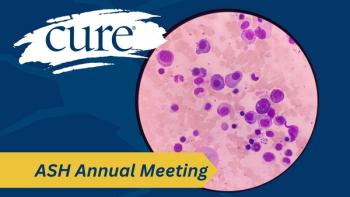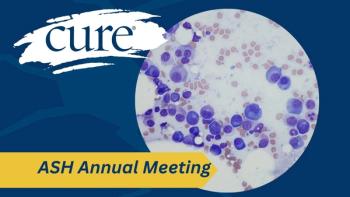Among patients with extensive-stage (ES) small cell lung cancer (SCLC), treatment with Imdelltra (tarlatamab) plus frontline chemotherapy and PD-L1 maintenance therapy was associated with positive safety and clinical outcomes, according to cohort results of the phase 1b DeLLphi-303 study presented during the European Society for Medical Oncology Congress 2025 and that were simultaneously published in The Lancet Oncology.
At a median follow-up of 13.8 months, the objective response rate (ORR) was 71%, with a complete response rate of 5% and a partial response rate of 66%; 11% of patients had stable disease. Eight percent of patients had progressive disease, and 9% of patients’ responses were not evaluable (NE).
The median duration of response (DOR) was 11 months, the disease control rate was 82% and the median duration of disease control was 10.7 months. Additionally, disease control was sustained for at least 52 weeks in 39% of patients, with ongoing responses in 49% of patients at data cutoff with data continuing to mature, said lead study author Dr. Martin Wermke, director of Trial Management/Early Clinical Trial Unit, NCT/UCC Early Clinical Trial Unit, of the German Cancer Research Center, University Hospital Carl Gustav Carus Dresden in Dresden, Germany.
Glossary
Objective response rate (ORR): the percentage of patients in a clinical study whose cancer significantly shrinks or completely disappears after receiving a specific treatment.
Duration of response (DOR): the length of time that a patient's cancer remains controlled (either shrinking or gone) without the disease progressing.
Disease control rate (DCR): the percentage of patients whose cancer either shrinks, disappears or stays stable (does not grow significantly) for a period of time after treatment.
Cytokine release syndrome (CRS): a side effect of some immunotherapies that involves a rapid, large release of immune substances (cytokines) into the blood, causing symptoms like fever, fatigue and sometimes more serious problems.
Immune effector cell-associated neurotoxicity syndrome (ICANS): a possible side effect of certain immune-based cancer treatments that causes symptoms related to inflammation of the brain or nervous system, such as confusion, difficulty speaking or seizures.
ECOG performance status: a simple scale (from 0 to 4) used by doctors to measure and track a cancer patient's overall well-being and ability to perform everyday activities.
Regarding safety, with a median duration of treatment of 46 weeks, three dose-limiting toxicities were observed overall, with all patients experiencing treatment-related side effects that were grade 3 (severe, 43%) or 4 (life-threatening, 35%), with one patient who died from a treatment-related side effect due to sepsis, attributable to the chemotherapy component of the regimen, Wermke said.
Imdelltra-related side effects that led to treatment discontinuations occurred in 6% of patients, and immune-related adverse events — not including cytokine release syndrome (CRS), immune effector cell-associated neurotoxicity syndrome (ICANS) and associated neurological events — were reported in 2% of patients.
The addition of Imdelltra to chemoimmunotherapy demonstrated a manageable safety profile that was consistent with the profiles of each individual agent, explained Wermke.
“I hope I could convince you that the combination of another frontline chemoimmunotherapy [that is] PD-L1 targeting in the maintenance [setting] is safe and has a manageable toxicity profile,” Wermke said in an oral presentation of the data. “There is no indication of additive or synergistic toxicity.”
Currently, standard treatment for patients with ES-SCLC comprises chemoimmunotherapy followed by PD-1/PD-L1 treatment as maintenance. Imdelltra is a bispecific T-cell engager that has been assessed in the second-line setting as a single agent in the phase 3 DeLLphi-304 trial and in the frontline maintenance setting with a PD-L1 inhibitor in this patient population, as seen in parts 5, 6 and 8 of the phase 1b DeLLphi-303 study.
At the 2025 ESMO Congress, Wermke presented on safety and efficacy outcomes from parts 2, 4 and 7 from the phase 1b DeLLphi-303 study, which explored Imdelltra in combination with frontline chemoimmunotherapy, followed by Imdelltra with PD-L1 maintenance therapy in patients with ES-SCLC.
The study enrolled adult patients with ES-SCLC who had received one cycle of chemoimmunotherapy, consisting of platinum-etoposide plus an anti-PD-L1 inhibitor, regardless of response to therapy. Patients were also required to have measurable disease, an ECOG performance status of 0 or 1, and no active autoimmune disease or disease that required immunosuppressive therapy. Those with treated and asymptomatic brain metastases were permitted.q
In cycles 1 to 3, patients received Imdelltra at 20 mg intravenously (IV) every three weeks plus platinum-etoposide (carboplatin to match area under the curve 5 IV on day 1 and etoposide at 100 mg/m2 on days 1 to 3) and a PD-L1 inhibitor, which consisted of Tecentriq (atezolizumab) at 1200 mg IV every 3 weeks or Imfinzi (durvalumab) at 1500 mg IV every three weeks. In the frontline maintenance setting, which was cycles 4 and beyond, patients received Imdelltra at 20 mg IV every three weeks plus either of the PD-L1 inhibitors at the aforementioned doses. Treatment was administered until disease progression.
The coprimary end points were dose-limiting toxicities, treatment-emergent side effects and treatment-related side effects; secondary end points were ORR, DOR, disease control, progression-free survival (PFS), and overall survival (OS).
Regarding baseline characteristics, the median age across both arms was 63 years, and 67% of patients were male. Patients were mostly White (74%), followed by Asian (16%), Other (9%) and Black (1%). At diagnosis, 77% had ES disease and 55% had an ECOG performance status of 1. Three-fourths of patients were former smokers, and 67% had prior receipt of a PD-L1 inhibitor in the first standard-of-care cycle; 16% and 45% of patients had treated asymptomatic brain metastases and liver metastases, respectively. The median sum of diameters of target lesions was 82.3 mm.
Wermke noted that the trial was not designed to compare the PD-L1 inhibitors and there were no randomizations between the treatment arms, adding that there were imbalances in baseline characteristics between the Tecentriq and Imfinzi groups.
Further efficacy data showed that the median PFS was 10.3 months starting from the first dose of Imdelltra treatment; the Kaplan-Meier estimate of the 12-month PFS rate was 43.1%. The median OS is not yet estimable; however, the Kaplan-Meier estimate of the 12-month OS rate with the Imdelltra regimen was 80.6%.
Investigators also assessed treatment-emergent CRS and ICANS by cycle, which primarily occurred during cycle 1 of Imdelltra (59%) and were mostly of grades 1 (mild)/2 (moderate); all CRS/ICANS events resolved. CRS and ICANS events led to both dose interruptions and discontinuations in 1% of patients each, with no fatalities reported. The median time to CRS onset from the last prior Imdelltra dose was 13.3 hours, and the median time to ICANS onset from the same time point was five days.
Wermke concluded that these data support further investigation of this regimen, which will be explored in the phase 3 DeLLphi-312 study.
References
- “Tarlatamab with first-line chemoimmunotherapy for extensive stage small cell lung cancer (ES-SCLC): DeLLphi-303 study,” Dr. Martin Wermke et al., Ann Oncol. Abstract 2757O.
For more news on cancer updates, research and education, don’t forget to subscribe to CURE®’s newsletters here.






